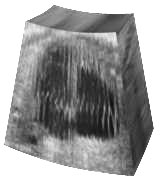Article 15
4D ultrasound volume image processing — animation building

When scanning periodically moving objects like human heart with the help of ultrasound probe 4D image is got. Because of the limited speed of sound it is not possible
to take instant shots of the heart phases to create usual movie. Ultrasound 3D shot acquisition takes long time enough to get image containing both 3D space and time information —
in other words we get 4D image.
To visualize heart moving we should transform 4D data into succession of 3D frames every one containing some phase of heart motion. That is we are to extract instant 3D shots
from 4D image to create frame succession to be animated in usual way.
To solve the task next steps to be performed:
- First of all we are to define frequency of the object moving inside voxel volume;
- Then we are to extract 2D slices of the predefined phases from the 4D volume to form 3D frames;
- Since all slices are at different positions we are to interpolate our 3D frames to get volumes that could be visualized successively.
To define frequency it is good idea to use FFT. After defining frequency
we can label 2D slices inside 4D volume with phase information and extract corresponding 2D slices to form 3D phase frames. All 2D slices have different space position and
thus got 3D volumes could not be visualized directly. Generally speaking they could but resulting movie contains spurts. To build smooth animation the got 3D volumes
to be interpolated to reposition 2D slices at the same locations in every frame.
In fig. 1a depicted the input 4D voxel image of the scanned heart and in fig. 1b you can see the result movie extracted from it —
click Play button for animation.
| a. |
 |
b. |
|
Fig. 1. Input 4D volume image (a) and result movie extracted from it (b).
For processing huge data arrays like 4D voxel images speed is a critical point. For Pentium IV at 3.2 GHz the solution we have built has performance 78 Mb/sec.
|




